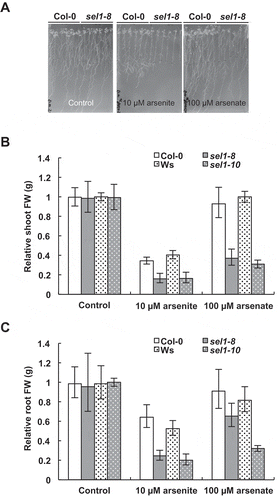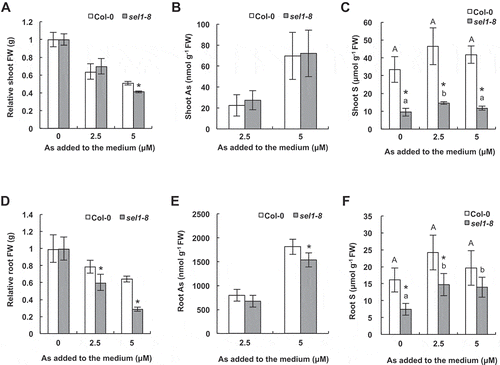Figures & data
Figure 1. Arsenic (As) tolerance in the Arabidopsis thaliana wild type and sultr1;2 defective mutants. (A) One-week-old seedlings were exposed to 10 µM arsenite or 100 µM arsenate conditions for a week. (B, C) Relative fresh weights (FW) of the shoots and roots, per those of Col-0 grown under control condition. Data are geometric means ± standard deviation (SD), n = 4.

Figure 2. Arsenic (As) and sulfur (S) concentrations in the wild type and sultr1;2 defective mutant. One-week-old plants were exposed to 0–5 µmol L−1 As (arsenite) for 9 d. (A, D) Fresh weight, (FW) (B, E) As concentrations and (C, F) S concentrations in shoots and roots. Data are means ± standard deviation (SD), n = 4. Asterisks at each As treatment indicate significant difference (P < 0.05) between Col-0 and sel1-8. In (C) and (F), the different letters in each series (upper case for Col-0 and lower case for sel1-8) indicate a statistically significant difference (P < 0.05, analysis of variance (ANOVA) Tukey’s Honestly Significant Difference (HSD)) between treatments.

Figure 3. Thiol concentrations in the wild type and sultr1;2 defective mutant. One-week-old plants of Col-0 and sel1-8 were exposed to 0–5 µmol L−1 As (arsenite) for 9 days. (A, D) Phytochelatins (PCs) (B, E) cysteine (Cys) and (C, F) glutathione (GSH) in shoots and roots. Data are means ± standard deviation (SD), n = 4. Asterisks at each As treatment indicate significant difference (P < 0.05) between Col-0 and sel1-8. The different letters in each series (upper case for Col-0 and lower case for sel1-8) indicate a statistically significant difference (P < 0.05, analysis of variance (ANOVA) Tukey’s Honestly Significant Difference (HSD)) between treatments.

